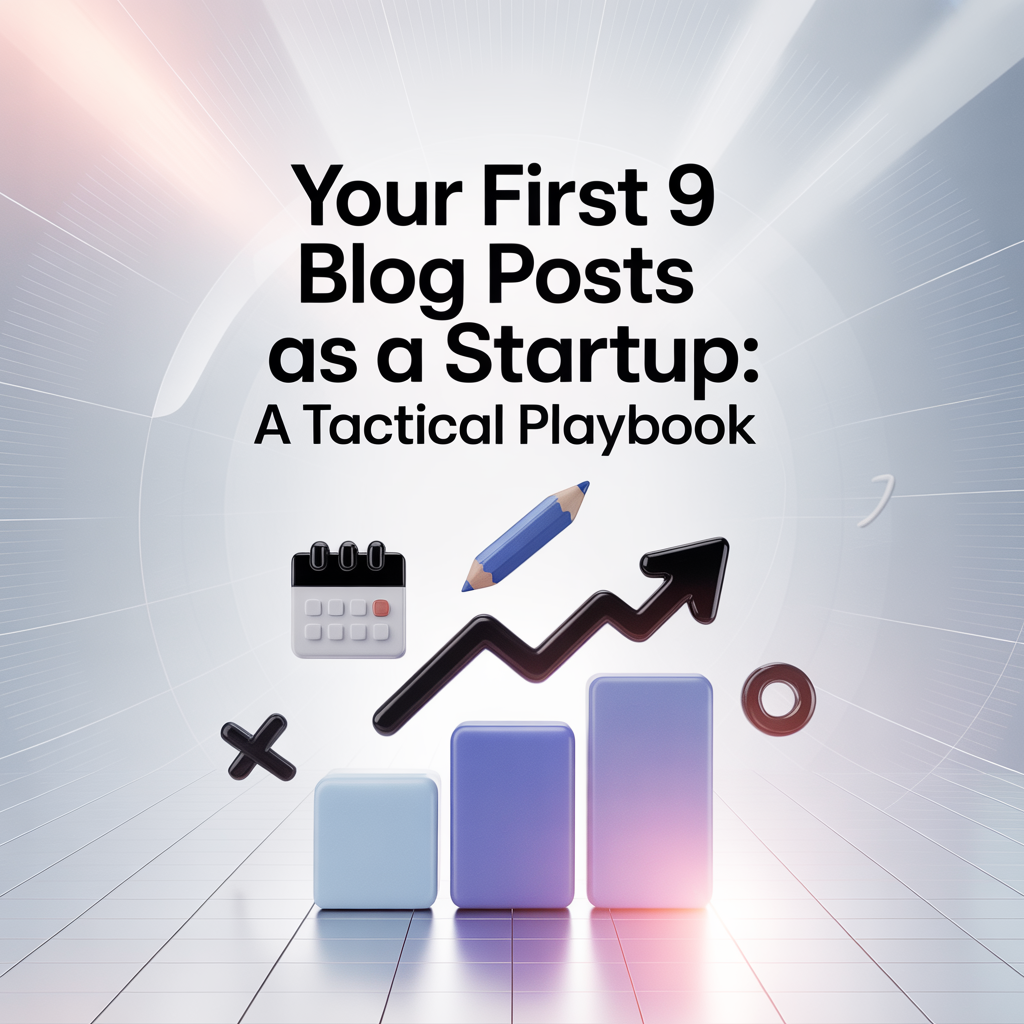Your First 9 Blog Posts as a Startup: A Tactical Playbook for 2025
May 12, 2025

Your First 9 Blog Posts as a Startup: A Tactical Playbook for 2025
It can be quite daunting at first. You've created your dream SaaS, you've got a little following on X or another Social Media platform, and you want to start driving traffic from SEO. Where do you start?
Most founders understand the basics of SEO, but don't really know where to start with getting there first few blog posts out to the world.
In this post I'll give you an exact tactical playbook for a startup / SaaS on going from no content to a 9 week SEO posting plan across your blog and social media.
Introduction - Your First 9 Blog Posts as a Startup: A Tactical Playbook
Why does it matter to be writing content? Google process 99,000 search requests per second, or to put it in a different way, that's 5 trillion searches a year! If you're not ranking in Google, you are missing out on potentially 10's of thousands of leads.
Let me give you some advice: Something is better than nothing.
Don't over think these first posts, just get them written and get them out. Perfecting your SEO strategy can come later.
Those first few blog posts don't need to be 100% optimized, but do need to be clear, honest and useful. Don't write for Google, write for yourself and your potential customer
In this post, I'll give you my tactical structure that has worked, not only for me, but for many of my clients.
This playbook works just as well for early-stage SaaS, Startups and Small Businesses.
The Right Mindset
Before we start with the details of which blog to write first, let's talk about mindset in these early stages of writing.
Eventually, you will want to do a mixture of writing for your user and also writing for the almighty Google.
To start with though, don't worry about the SEO machine or the algorithm, just focus on writing for your future customer.
Follow these basic tactics at the start:
- Customer First - You've a great SaaS, a great Startup, a great business - who is that business aimed at? What do you want them to know about the business and about you? Write for your customer. Be free, be easy and be you.
- Be Useful: You're not looking for that killer hook that will go viral. Your first posts aren't supposed to be viral. Be useful and try to help your future customers.
- You don't need to sell: To start with, you aren't trying to sell. You are trying to build trust and authority. Selling can come later.
- Consistency: Be consistent in your posting. People may start to expect a post from you a week. Don't let them down.
Ok, now let's dive in to my recommendations for your first 10 blog posts. These are the same recommendations that I give to all of my clients. When done well, they work (and remember, by "work" I mean build trust, build a writing habit and start to build some authority for your site).
Let's dive in to the best first blog posts for startups and SaaS founders.
The 9 Foundational Blog Posts that work in 2025
1. Your Founder’s Story
The first post I always tell Startups and new SaaS owners to write, is their story.
What problem are you solving and why.
People buy from people and people trust people. If you tell your own story of why you started your product, that's a great insight in to you and why you wanted to solve this particular problem.
Show the problem you are solving as you see it.
This post is not a deep dive in to the product, that comes next. This is building a connection with your audience.
Example titles:
• “Why I’m Building [Product Name]”
• “From [Background] to Startup Founder: My Shift Into SaaS”
2. The Problem Deep Dive
Now that people have an overview of who you are and why you started to build your product, we can take a deep dive in to the problem itself.
People need to know that you understand the problem through and through. They need to know that if they are going to trust you with their money, you know pain points that they feel. You know the nitty gritty of what they are going through and you are able to solve it.
You're not trying to pitch your solution here, you are empathizing with your audience and further strengthening that connection.
Example titles:
• “The Hidden Cost of [Problem]”
• “Why [Pain Point] is Holding Back Small Teams”
3. Current Solutions (and Their Flaws)

This post is assuming that there is a solution to the problem on the market today. Assuming that you've not invented the hoverboard, there is likely a competitor to what you have built. That may be two products from two different people, which when combined do what you do, but there will be something out there.
Why didn't you just use what someone had already built? What was it about those products that didn't fill your need? What does your product do better, differently or at a different price point to theirs?
Example titles:
• “How People Are Solving [Problem] Today — And Why It’s Not Enough”
• “The Limitations of [Tool or Approach] for [Audience]”
4. Beginner’s Guide to Your Niche
You should never assume that your audience knows as much as you do about your niche. If you've just built a Saas/Startup around a niche, you will more than likely know it better than 99% of people out there. If you write with those assumptions in mind, you'll likely lose your audience quickly. I've seen it many times. Founders write with too many acronyms, industry jargon and techy language and quickly lose the interest of their audience. Keep it simple, but explain it well (this is a very hard skill to learn!)
Example titles:
• “What Even Is Programmatic SEO?”
• “A Beginner’s Guide to [Industry Concept]”
5. Top 5 Mistakes People Make
For starters, everyone loves a list! I can't remember where I read it, but someone once guessed that eventually the internet would be one big compilation of lists.
Anyway, let's write a list of the mistakes that people generally make in your niche. This shows that you understand the niche well and that you are also trying to help.
These types of blog post are quite easy to write (assuming you know your niche well) and are highly sharable (again, everyone loves a list).
Example titles:
• “5 Costly Mistakes Early SaaS Teams Make with SEO”
• “The Most Common [Niche] Mistakes (and How to Avoid Them)”
6. Mini Case Study (Even If It’s Just You)
Now that we've built some trust, let's start diving in to the details of the industry.
If you already have some data of your own, or some wins or losses that you can share, write them up.
People love real data.
"In God we trust, all others, bring data"
These posts are intriguing and interesting. In my experience, case study posts are one of the most highly read, highly shared and highly linked to blog posts you can write.
Example titles:
• “How I Got My First 50 Email Signups Without Ads”
• “What Happened When I Changed My Landing Page Copy”
7. Industry Trends You’re Watching
Your Saas / Startup / Business fits in to a wider industry. Start writing about that industry.
Take a look through emerging trends and add your own unique take on them. You can be contrarian here, and often that is a good thing. Shown your personal beliefs, personal experience and expertise for your industry. That builds trust and authority like nothing else.
Example titles:
• “What’s Changing in [Industry] and What It Means for Founders”
• “Why [Trend] is Bigger Than We Think”
8. What We Learned from Launching [X]
People love seeing how the cake is made.
Bring them in to your world. Share the highs, the lows and everything in between.
Every launch and build has something that you or others can learn from it. What's your story and how can it help or entertain others?
Don't just share the wins, share the failures and losses. People connect more with real and honest people. The losses and failures can help others and that really does matter when building an audience.
Example titles:
• “We Just Launched Our MVP — Here’s What We Learned”
• “Building in Public: What Worked, What Didn’t, and What’s Next”
9. The Vision Post

This is a fun one. Fun to write, fun to read and fun to look back on in a years time and see how correct it was.
You've hopefully now got a little following and a good audience. Tell them where you want to go and where you see your product in 6-12 months. You don't need to stick with this, we should be agile after all, but people want to know that your product has a future to it. If they are going to sign up and pay you, they want to know that you have a plan.
You aren't selling here still, but simply showing that you aren't planning on going live and then letting the product grow dusty and sit on a self somewhere.
Example titles:
• “Where We’re Going (And Why You Might Want to Come Too)”
• “What We Want to Change About [Industry]”
Summary - 9 Week Content Plan
| Week |
Post | Goal / Purpose |
|---|---|---|
| 1 | Founder’s Story | Build trust and connect with your audience |
| 2 | Problem Deep Dive | Show empathy and understanding of the user’s pain |
| 3 | Current Solutions (and Their Flaws) | Position your product by exposing market gaps |
| 4 | Beginner’s Guide to Your Niche | Educate newcomers and establish expertise |
| 5 | Top 5 Mistakes People Make | Offer quick, sharable insights + build authority |
| 6 | Mini Case Study (Even if it’s just you) | Share data-backed experience and practical proof |
| 7 | Industry Trends You’re Watching | Demonstrate awareness, perspective, and foresight |
| 8 | What We Learned from Launching [X] | Build credibility through transparency |
| 9 | The Vision Post | Inspire belief and hint at long-term roadmap |
How to Publish Without Burning Out
You have enough on your plate being a founder and creating a business. You don't need extra stress of writing 9 Blog Posts looming over you.
The unfortunate truth is that you need to write content on your site for it to trusted and rank, but you don't need to do it all today. Companies that have more blog posts, get a lot more traffic.
Come up with a realistic posting schedule, maybe once per week and start there.
Think of each post at a time, rather than filling your brain with all 9 at once.
Don't aim for perfection
You don't need to be perfect to start with. Be passionate sure, but not perfect.
Perfection is the enemy of the good!
Focus on getting your words on the page and building a connection with an audience. SEO and all of that can come later.
These are startup blog ideas that build trust, build an audience and build a rhythm. They aren't a fully fledged Keyword Strategy that's targeting high volume traffic. Use that to your advantage. Don't take the posts too seriously.
Sharing on Socials

Once you've written your posts, find where you target audience hang out, and then share the posts on there.
At this early stage, you won't be discovered by Google (that's why you are starting to write, to build that initial trust with Google), and presumably you want people to read what you have written, so the easiest way to get things out there is via social media.
Create an account on a platform where you ideal customers are (X, Reddit, LinkedIn, Indie Hackers, Facebook, Instagram etc.), start engaging, following and posting. Get some readers, start getting feedback, loop.
Repurpose Content
When you write these blog posts, you can repurpose the content in multiple places.
It would be a waste to spend this time writing and only get the rewards from one stream.
Using a tool like RankReady, you can create your content and then ask it to generate you a set of X/Twitter posts, Short Video scripts and long form video scripts. You are using all of your own content, but leveraging the tools to distribute it to different platforms.
You can also start assembling email addresses and use them for a newsletter. A newsletter is the perfect accompaniment to a blog posts as the are both written mediums.
Gradually introduce some basic SEO concepts
Now you're in the swing of writing and publishing, start to introduce some basic SEO:
Internal Linking.
This is where you link between each of the posts that you've written. It's a key SEO concept and helps people navigate your site as well as helping Google navigate your site.
That's it for now on the SEO front. We can delve in to that more in the future.
Case Study: An Education business 12x their organic traffic.
The latest client I've worked with in improving their SEO visibility was an company in the Education industry.They wanted to understand why they weren't appearing in Google for areas in which they clearly had expertise, and were mentioned on their home and services page.
I explained the process that is required to build the trust and authority in the eyes of Google and they became overwhelmed at where to start.
I get it, I really do. Going from nothing to something is hard. But going from something to more things is easier.
I set them this 9 step tactical playbook for getting started, and by the end of it they were in the rhythm and routine of writing and had built a nice following along the way.
From then, when we talked about a "Keyword Strategy" and "Topical Authority", they were much less scared and much more ready to start writing about the topics that were going to get them the real traffic.
They've since 12x their organic traffic and that is continuing to rise as they keep publishing more and more useful content.
We tracked their performance through Google Analytics and Google Search Console, tweaked a few things along the way, but mostly they just published and slowly began ranking.
Conclusion
Well there you go. That wasn't so scary, was it?
This is the same 9-post plan I've used I've used with SaaS Founders, Small Business Owners and Startups. When a process works, it works.
We took a look through the first blog posts for startups and what they'll achieve. Hopefully it was informative and broke down some barriers between you and starting your SEO and content journey.
These first 9 blog posts you can probably write with your eyes shut and will start your site gaining momentum with Google as well as start hopefully getting a following from potential leads.
Remember, these don't have to be perfect blog posts. They don't have to be perfectly SEO optimised. They need to be human, informative and set you up for building some trust.
Feel free to reach out if you need any extra help with starting your SEO and content journey.
--Ben